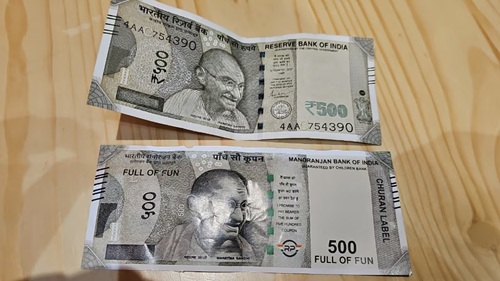The ₹500 currency note is one of the most commonly used denominations in India. Due to its high value, counterfeit ₹500 notes are often circulated, posing a risk to individuals and businesses. Identifying a fake ₹500 note is crucial to prevent financial loss and to ensure smooth transactions. The Reserve Bank of India (RBI) incorporates several security features in genuine ₹500 notes, which can be used to distinguish them from counterfeit ones.

1. Security Features of Genuine ₹500 Notes
Genuine ₹500 notes, especially those of the Mahatma Gandhi (New Series), have multiple security features:
a) See-through Register with Denomination
- Look at the ₹500 number printed on the front and back; when held against light, both numbers align perfectly to form the complete figure.
- Fake notes often have misaligned or blurred printing.
b) Watermark
- Genuine notes have a portrait of Mahatma Gandhi and an electrotype 500 watermark visible when held against light.
- Fake notes may have faint or distorted watermarks, or none at all.
c) Security Thread
- A windowed security thread runs through the note, reading “भारत (Bharat)” and “RBI.”
- The thread changes color from green to blue when the note is tilted.
- Fake notes may have painted or printed threads that do not change color or are fixed.
d) Color Changing Ink
- The numeral 500 on the lower right front side is printed with color-changing ink.
- When tilted, it changes from green to blue.
- On counterfeit notes, this ink is often static and does not shift colors.
e) Micro-lettering
- Genuine notes have “RBI” and “500” printed in micro-letters near Mahatma Gandhi’s portrait.
- These are clearly visible under magnification. Fake notes may omit or blur micro-lettering.
f) Intaglio Printing
- The portrait of Mahatma Gandhi, the Ashoka Pillar emblem, and RBI seal are printed in raised (intaglio) ink, which can be felt by touch.
- Fake notes may feel flat or smooth instead of textured.
g) Latent Image
- A latent image of the denomination 500 appears on the right-hand side when the note is held at eye level.
- Counterfeit notes often lack this feature or have it poorly printed.
h) Optically Variable Ink and Colour Palette
- Genuine ₹500 notes have a multi-color design with shades of stone grey and yellow.
- Fakes often have incorrect or dull colors.
2. Other Practical Tips
- Check the paper quality: Genuine notes are printed on special cotton-based paper, which feels soft but firm. Fake notes may feel too thin, rough, or glossy.
- Compare with a known genuine note: Placing the suspected note next to a real one helps detect size, color, and print discrepancies.
- Use UV Light: Under ultraviolet light, genuine ₹500 notes show fluorescent fibers and marks. Counterfeit notes often lack proper UV features.
- Check Serial Numbers: Genuine notes have unique serial numbers printed in consistent fonts. Fake notes may have repeated numbers or irregular fonts.
Quick Identification Table
| Feature | Genuine ₹500 Note | Fake Note |
| Watermark | Mahatma Gandhi + Electrotype 500 | Faint, distorted, or missing |
| Security Thread | Color-changing, windowed, with RBI/Bharat | Static or painted thread |
| Color-Changing Ink | Changes from green to blue | No color change |
| Micro-lettering | “RBI” and “500” clearly visible | Missing or blurred |
| Intaglio Printing | Raised texture on portrait & emblem | Flat, smooth |
| Latent Image | Visible on tilt | Absent or poorly printed |
| Paper Quality | Cotton-based, soft yet firm | Thin, rough, or glossy |
Final Thoughts
Identifying a fake ₹500 note is crucial for financial security. By carefully examining watermarks, security threads, color-changing ink, micro-lettering, and paper quality, anyone can distinguish genuine notes from counterfeit ones. Always be vigilant during transactions, and if you suspect a counterfeit note, report it immediately to local authorities or the RBI. Knowledge of these features ensures safe transactions and protects you from fraud.